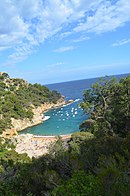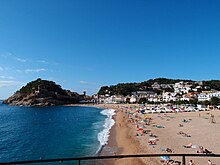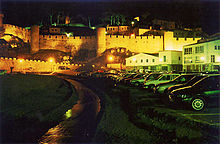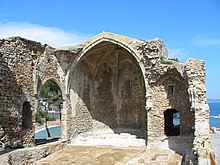Tossa de Mar
| Tossa de Mar municipality | ||
|---|---|---|
 The castle of Tossa de Mar
|
||
| coat of arms | Map of Spain | |

|
|
|
| Basic data | ||
| Autonomous Community : | Catalonia | |
| Province : | Girona | |
| Comarca : | La Selva | |
| Coordinates | 41 ° 43 ′ N , 2 ° 56 ′ E | |
| Height : | 5 msnm | |
| Area : | 38.54 km² | |
| Residents : | 5,683 (Jan 1, 2019) | |
| Population density : | 147.46 inhabitants / km² | |
| Municipality number ( INE ): | 17202 | |
| administration | ||
| Mayor : | Maria del Pilar Mundet i Torres | |
| Website : | www.tossademar.com | |
Tossa de Mar is a popular Catalan seaside resort with a historic old town and fortress on the Costa Brava in the Comarca La Selva in the province of Girona ( Spain ).
Location and geography
Tossa de Mar is located in a bay between rocky cliffs that drop steeply to the Mediterranean Sea, about 90 km northeast of Barcelona and 85 km southwest of Portbou on the French border. Tossa is traversed by the Tossa River (Riera de Tossa) of the same name , which flows into the sea below the city wall. The vegetation is characterized by cork oak , pine and pine forests in the middle of the rugged coastal mountains ( Massís de l'Ardenya ). There are small beach bays between the capes, two of which have been awarded the Blue Flag . The largest nature reserve further inland is the national park in the Gavarres Mountains, which is one of the Pla d'Espais d'Interès Natural areas legally designated by the Catalan government on December 14, 1992 .
history
According to archaeological finds (stone tools and ceramics), the area around Tossa de Mar was already settled in the Neolithic . In the mountains around Tossa there are Stone Age graves with the Paradolmen d'en Garcia and Paradolmen de Ses Rat. A Roman settlement with an Iberian forerunner was discovered in 1914 on what is now the western edge of the town. The excavations of 1934 brought to light the ruins of an oil mill, a villa, a thermal bath, and coins from the 1st to 4th centuries AD. The name of the settlement - Turissa - and the villa owner - Salvo Vitale - have come down to us from a floor mosaic .
In the early Middle Ages the ownership structure of Tossa appears in some documents. In 966 Count Miró of Barcelona ceded the land to the Benedictine Abbey of Santa Maria de Ripoll ; this retained the formal sovereignty over the surrounding area until the end of feudalism in Spain in 1835. In 1187 the abbot of Ripoll granted Tossa de Mar town rights.
Between the 12th and 14th centuries the settlement was walled and provided with 7 fortification towers. A church was built on the Guardí hill, the ruins of which are still partially preserved. The fortress to protect against pirates was extended in the 16th century under Philip II by a watchtower , called Torre dels Moros ("Moors Tower").
Around 1500 the first houses outside the city walls were handed down, and in the following centuries the expansion of the place continued within its natural boundaries between the rocky mountains.
Until before World War II, agriculture and forestry were the main sources of income for Tossa de Mar. Cork was exported worldwide and the local wine was also highly valued. Although the place is on the coast, fishing was only in third place and is still the livelihood of a few local families. In the first half of the 20th century writers and artists discovered the picturesque backdrop of the place; because it is the only coastal town on the Costa Brava whose city fortifications around the historic old town are almost completely preserved. Marc Chagall , who often chose Tossa's scenery as his motif in the 1930s, named the city The Blue Paradise .
The tourist boom in the community began after the film Pandora and the Flying Dutchman with Ava Gardner and James Mason was shot in Tossa in 1951 . Tossa de Mar hardly took part in the construction boom of the 1960s and 1970s to develop package tourism on the Costa Brava; however, the infrastructure reaches its capacity limits in the peak times of the summer months, when Tossa has to cope with ten times its population in visitor flows. Now that the main beach has also been opened for leisure boats, it is hopelessly overcrowded in the two summer months.
tourism
Three sandy beaches and an attractive promenade characterize the seaside tourism in the place. The northern Platja de la Mar Menuda in a bay only 180 m long is coarse-grained, pebbly and bordered by rocks. Due to its legend San Ramón de Penyafort , this beach, which is also a paradise for divers, is known throughout Spain. The city beach - Platja Gran , 400 m long and 50 m wide - is also coarse sand, but very popular because of its close proximity to the old town and fortress and numerous cafes and restaurants on the promenade to the tourist port, where excursion boats land several times a day. A small beach, protected from the wind, south of the fortress (90 m, Platja del Codolar ) is quietly located below the historic town center. There are also eleven other beaches and bays in the municipality of Tossa de Mar.
The tourist infrastructure is characterized by small and medium-sized hotels, guest houses, holiday apartments and campsites. Most of the restaurants are located on the promenade, but some are also in the steep streets of the old town and within the city walls.
Excursions with glass-bottom boats and ship excursions along the rugged coast northeast to Sant Feliu de Guíxols and further to Palamós or southwest to Blanes are on offer.
In Tossa de Mar there is also an approx. 13 km long panoramic road northeast to Sant Feliu de Guixols through a rugged rocky landscape amidst holm oak and pine forests high above small sandy bays with holiday apartment settlements and campsites. The road runs in hairpin bends close to the edge of the cliff; Several parking bays offer viewpoints ( miradores ) of the bizarre landscape, which Ferran Agulló presumably had in mind when he named the 220 km long Mediterranean coastline between the French border and Barcelona in 1908 the name Costa Brava . A number of small bays with beaches and small settlements of holiday homes belonging to the municipality of Tossa can be found on this stretch of coast and can be reached from the coastal road. There are also a number of small beaches south of the city. These are:
| bay | location | image |
|---|---|---|
| Cala Bona | ⊙ 3 km north of Tossa |

|
| Cala Llevadó | ⊙ 3 km south of Tossa | |
| Cala Pola | ⊙ 4 km north of Tossa |

|
| Cala d'en Carlos | ⊙ 3 km south of Tossa | |
| Cala Giverola | ⊙ 5 km north of Tossa |

|
| Cala Llorell | ⊙ 3.5 km south of Tossa | |
| Cala Futadera | ⊙ 6 km north of Tossa | |
| Cala de Porto Pi | ⊙ 4.5 km south of Tossa | |
| Cala Salionç | ⊙ 8 km north of Tossa |

|
| Cala Morisca | ⊙ 5 km south of Tossa | |
| Platja de Vallpregona | ⊙ 11 km north of Tossa |
Attractions
Tossa de Mar is divided into an old town ( Vila Vella ) and a "new town" ( Vila Nova ), which, however, also includes historic streets and buildings. The difference is that the old town , which is under monument protection, lies within the medieval city wall with defensive towers and the new town outside.
In addition to the old town, a large number of other buildings are listed. See the list of cultural monuments in Tossa de Mar .
Vila Vella
- The city wall with 7 towers was built in the 12th and the beginning of the 13th century; it took its final form, which is essentially visible today, at the end of the 14th century. Of the 7 towers, 3 are built in a cylindrical shape and still have their original names: Torre des Codolar , Torre de ses Hores ( hourly tower ) and Torre d'en Joanàs on a rocky cape by the sea. The other four towers are larger.
- From the pirate fortress on the hill, which was expanded in the 16th century, there is still a watchtower ( Can Magí ).
- The apse, remains of the nave and the right transept are preserved from the Gothic church ruins near the fortress.
- Around 80 houses are still inhabited in the narrow streets that lead up through the steep stairways through Villa Vela. There are also some bars in it.
- The former governor's palace on the south side of the old town has been used as the Museu Municipal since 1935 . In addition to archaeological finds from the Neolithic and from the previous Roman settlement, pictures by the artists who discovered the site as a motif after 1900 are presented; besides Marc Chagall there were also u. a. also Olga Sakharov and Oskar Zügel at work.
- The Roman Villa Ametllers (1st century BC - 6th century AD) belonged to the Roman province of Tarraconensis. It consists of two parts, the rural and the rustic. Visitors can get an impression of their value through the spa system, the central heating system, the mosaics and the fruit press systems. Parts of mosaics, stucco and elements of sculptures confirm the wealth of the owners at the time. The ceramic vases come from Mediterranean trade. Agricultural and fishing activities come to light through the various agricultural implements and tools and fishing rods. Everyday life is also illustrated by other objects such as hair clips, small spoons and bones, and ivory objects.
- The so-called Paris Church, which was dedicated to the martyr Vincent of Saragossa, was inaugurated on November 29, 1775 after a 29-year construction phase. The church is one of the largest in the diocese and can accommodate the entire population of Tossa de Mar during important festivities. Much of the facility was destroyed during the civil war in 1936. Inside the church is the chapel of St. Sebastian, a saint much venerated by local residents. He is remembered on January 20th every year.
Vila Nova
The streets of the lower town are the tourist center with a variety of eateries and small retail shops selling souvenirs and regional products.
- The 16th century chapel of Our Lady of Socorro is located on Plaça d'Espanya . It contains the fabric of a previous building, but has been redesigned several times.
- The baroque church of Sant Vicenç (begun in 1755) also replaced an older church building.
- The Sant Miquel Hospital for the Poor was built in 1733 by Tomàs Vidal i Rey. The two-wing complex with an inner courtyard has a chapel with a baroque altar.
- The archaeological excavation site of the Roman settlement is on the western edge of the lower town.
Outside the city
According to tradition, the local saint Gerbert d'Aurillac , founder of the Benedictine abbey of Aurillac , who was destroyed by the Huguenots and who worked in Catalonia in the 9th century , settled in the Ermita de Sant Grau . The Ermita is located 360 meters high in the mountains off the panoramic road to Sant Feliu de Guixols. The original building has been replaced by a neo-Gothic one from 1882. The panorama extends far over the rocky coastal mountains to the sea.
Municipal Museum
The city museum, built in the late Gothic style, is located within the old town. The building used to be the residence of judicial heads of government and envoys, such as B. the abbots of the monastery of Santa Maria de Ripoll.
The museum opened on September 1, 1935. It houses an important collection of contemporary art with works by Spanish and international artists who visited Tossa de Mar during the 1930s. The archaeological section shows finds that range from the Paleolithic Age to the late Middle Ages. Of particular importance are the mosaics that were found in the atrium of the Roman villa of the Ametllers and date from the end of the 4th century to the beginning of the 5th century.
Festivals
- January 20-21: El Pelegrí de Tossa ("The Pilgrim of Tossa") is a festival that dates back to the plague that raged in the city in the 15th century
- May 1st: Feast of the Holy Cross
- first Sunday in June: Dia del Pescador ('Fishermen's Day'), festival on the beach
- June 29th: Patron feast of St. Peter with sardanas , concerts, fireworks, shows of handicrafts
- last Sunday in August: Concurs de pintura ràpid ("quick painting competition")
- Every year, on the last weekend in September, a meeting of air-cooled Volkswagen takes place. During this event, the city will temporarily close several streets. The meeting is the largest in Spain and has been held in Tossa de Mar for twelve years. In 2005 the organizers spoke of over 200 participating vehicles.
- October 13: Pope Silvester II commemorates
literature
- Baedeker Travel Guide Costa Brava, Verlag Karl Baedeker, 4th edition 2000
Web links
- Official website
- Travel guide with beach pictures and helpful content in don-travel.de
- Photographs by Tossa (HDR photos) infotoossa.blogspot.com
- Photos and descriptions of objects of interest in Tossa de Mar in poblesdecatalunya.cat
Individual evidence
- ↑ Cifras oficiales de población resultantes de la revisión del Padrón municipal a 1 de enero . Population statistics from the Instituto Nacional de Estadística (population update).
- ↑ costabrava.org: Roman Villa Els Ametllers.Retrieved September 1, 2014.
- ↑ Museu Municipal de Tossa de Mar ( Memento of the original from January 22, 2015 in the Internet Archive ) Info: The archive link has been inserted automatically and has not yet been checked. Please check the original and archive link according to the instructions and then remove this notice. . City Museum website. Retrieved September 18, 2014.









